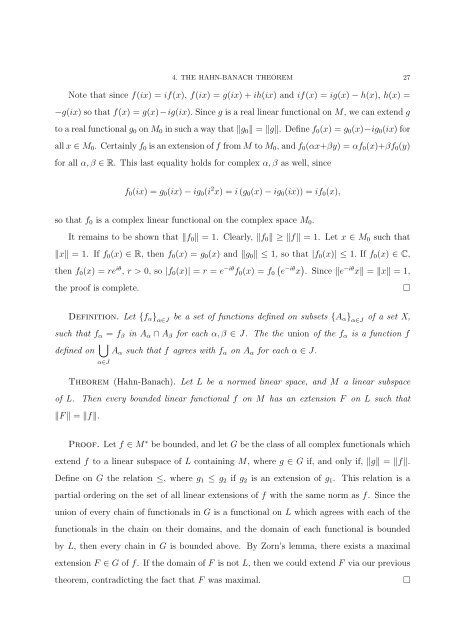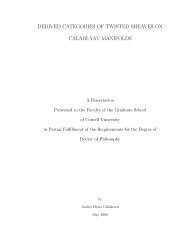FIVE MAJOR RESULTS IN ANALYSIS AND TOPOLOGY Aaron ...
FIVE MAJOR RESULTS IN ANALYSIS AND TOPOLOGY Aaron ...
FIVE MAJOR RESULTS IN ANALYSIS AND TOPOLOGY Aaron ...
Create successful ePaper yourself
Turn your PDF publications into a flip-book with our unique Google optimized e-Paper software.
4. THE HAHN-BANACH THEOREM 27<br />
Note that since f(ix) = if(x), f(ix) = g(ix) + ih(ix) and if(x) = ig(x) − h(x), h(x) =<br />
−g(ix) so that f(x) = g(x)−ig(ix). Since g is a real linear functional on M, we can extend g<br />
to a real functional g0 on M0 in such a way that g0 = g. Define f0(x) = g0(x)−ig0(ix) for<br />
all x ∈ M0. Certainly f0 is an extension of f from M to M0, and f0(αx+βy) = αf0(x)+βf0(y)<br />
for all α,β ∈ R. This last equality holds for complex α,β as well, since<br />
f0(ix) = g0(ix) − ig0(i 2 x) = i (g0(x) − ig0(ix)) = if0(x),<br />
so that f0 is a complex linear functional on the complex space M0.<br />
It remains to be shown that f0 = 1. Clearly, f0 ≥ f = 1. Let x ∈ M0 such that<br />
x = 1. If f0(x) ∈ R, then f0(x) = g0(x) and g0 ≤ 1, so that |f0(x)| ≤ 1. If f0(x) ∈ C,<br />
then f0(x) = reiθ , r > 0, so |f0(x)| = r = e−iθ <br />
−iθ −iθ f0(x) = f0 e x . Since e x = x = 1,<br />
the proof is complete. <br />
Definition. Let {fα} α∈J be a set of functions defined on subsets {Aα} α∈J of a set X,<br />
such that fα = fβ in Aα ∩ Aβ for each α,β ∈ J. The the union of the fα is a function f<br />
defined on <br />
Aα such that f agrees with fα on Aα for each α ∈ J.<br />
α∈J<br />
Theorem (Hahn-Banach). Let L be a normed linear space, and M a linear subspace<br />
of L. Then every bounded linear functional f on M has an extension F on L such that<br />
F = f.<br />
Proof. Let f ∈ M ∗ be bounded, and let G be the class of all complex functionals which<br />
extend f to a linear subspace of L containing M, where g ∈ G if, and only if, g = f.<br />
Define on G the relation ≤, where g1 ≤ g2 if g2 is an extension of g1. This relation is a<br />
partial ordering on the set of all linear extensions of f with the same norm as f. Since the<br />
union of every chain of functionals in G is a functional on L which agrees with each of the<br />
functionals in the chain on their domains, and the domain of each functional is bounded<br />
by L, then every chain in G is bounded above. By Zorn’s lemma, there exists a maximal<br />
extension F ∈ G of f. If the domain of F is not L, then we could extend F via our previous<br />
theorem, contradicting the fact that F was maximal.
















